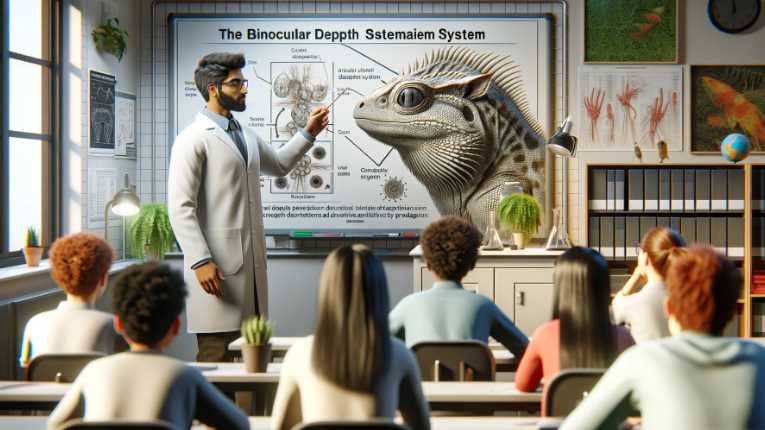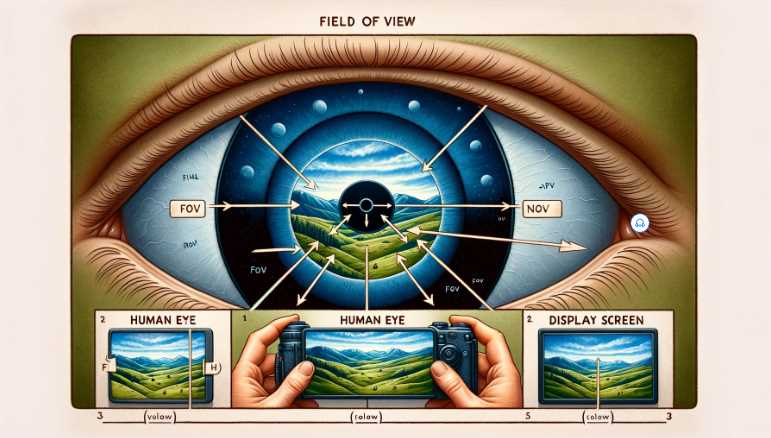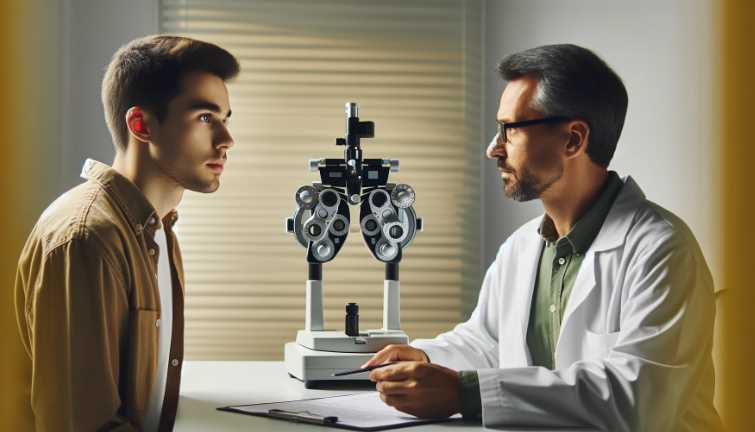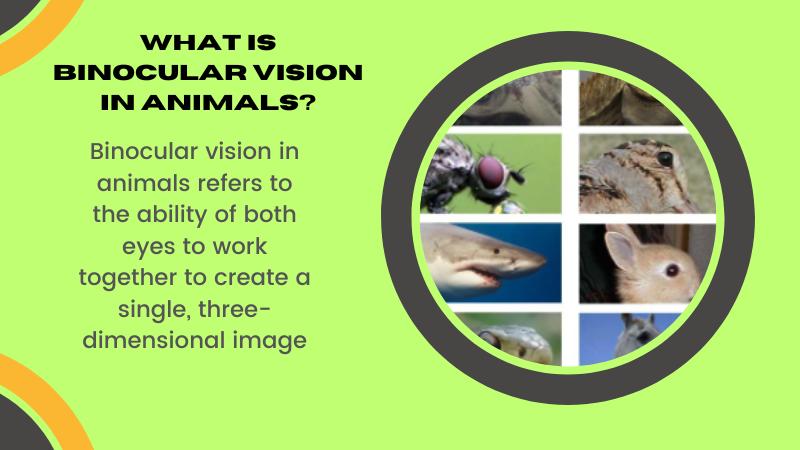The binocular depth system is advantageous for predators because it enhances their ability to perceive depth and distance accurately, facilitating precise targeting and efficient hunting.
Binocular depth perception is the ability to perceive the depth or distance of objects by combining visual information from both eyes. This system provides several advantages for predators:
- Depth Perception: Binocular vision allows predators to judge the distance to their prey accurately. This is crucial for planning and executing precise attacks, especially when predators need to cover short distances quickly.
- Targeting Accuracy: Predators often need to focus on a specific target, such as the vital organs of their prey. Binocular vision enables them to aim and strike precisely, increasing the likelihood of a successful hunt.
- Improved Hunting Strategies: With accurate depth perception, predators can better strategize their approach. They can choose optimal ambush positions or calculate the exact moment to pounce on their prey.
- Increased Field of View: Binocular vision is often associated with a wider field of view, allowing predators to monitor a larger area simultaneously. This broader perspective helps them detect potential threats or opportunities for hunting.

To illustrate the advantages of binocular vision, consider the following table:
| Aspect | Advantage for Predators with Binocular Vision |
|---|---|
| Depth Perception | Accurate judgment of distance for precise attacks |
| Targeting Accuracy | Enhanced ability to focus on specific prey areas |
| Hunting Strategies | Improved planning and execution of hunting tactics |
| Field of View | Wider perspective for monitoring larger areas |
| Overall Hunting Efficiency | Increased success rate in capturing prey |
Evolutionary Basis
From the dawn of time, the evolutionary journey has sculpted life forms into beings equipped to conquer their surroundings. The origins of binocular vision trace back through the annals of species evolution. Over millennia, predators developed this visual acuity as a specialized adaptation for hunting success. It’s not merely a coincidence; it’s an outcome of nature’s relentless quest for efficiency in survival.
Mechanism of Binocular Depth Perception
To truly grasp the advantage of the binocular depth system, we must first understand its mechanics. It relies on binocular disparity, a phenomenon where each eye perceives a slightly different image. The brain, acting as a master conductor, integrates these disparate images, creating a three-dimensional representation of the environment. This stereopsis, the fusion of visual information, is the key to the predator’s enhanced depth perception.
As I delve into the intricacies of the neural processes, it becomes evident that specific brain regions are responsible for this heightened perception. The orchestration of signals within these regions allows predators to discern distances accurately, giving them a tactical edge in the hunt.
Advantages of Binocular Depth System for Predators
Improved Depth Perception
Walking in the shoes of a predator, the world transforms with the precision of distance estimation. The binocular depth system offers an unparalleled advantage in gauging the distance to prey. This enhanced perception ensures a predator’s ability to strike with unparalleled accuracy, minimizing the margin for error in their pursuit of sustenance.
The precision in targeting prey becomes a strategic asset. Imagine a big cat stalking through the grasslands, eyes locked onto its unsuspecting prey. The binocular depth system allows for a calculated approach, ensuring a successful ambush and a higher likelihood of securing a meal.
Increased Field of View

The wide-eyed perspective of binocular vision presents a panoramic canvas for predators. Their field of view expands, offering a broader range of vision. In my exploration of this advantage, it’s akin to having a built-in surveillance system, allowing predators to monitor their surroundings for potential threats or opportunities. It’s nature’s way of providing a 360-degree awareness, a necessity for survival in the wild.
Efficient Hunting Strategies
As I witness predators in their natural habitats, the efficiency in their hunting strategies unfolds before me. The binocular depth system facilitates tactics like ambush and pounce. Predators capitalize on their enhanced depth perception to lay in wait, unseen, until the perfect moment to strike. It’s an energy-conserving approach, a testament to the evolutionary refinement of their predatory instincts.
Comparative Analysis with Monocular Vision
To appreciate the superiority of the binocular depth system, we must contrast it with its counterpart, monocular vision. Monocular vision lacks the depth perception granted by binocular vision, resulting in a reduced accuracy in distance estimation. The world viewed through a single eye pales in comparison to the rich tapestry of depth and dimension perceived by binocular vision.
The adaptive advantages of binocular vision become glaringly apparent when considering the evolutionary selection for predatory success. Predators equipped with binocular vision have a distinct survival advantage in varied environments, a testament to the potency of this adaptation.
Examples from the Animal Kingdom
As I observe nature’s theater, the stage is filled with actors showcasing the prowess of binocular vision. Birds of prey, exemplified by eagles, hawks, and falcons, soar through the skies with unmatched precision. Their hunting strategies and success rates stand as living proof of the advantages bestowed by binocular vision.
Mammalian predators, such as big cats (lions, tigers, leopards) and canids (wolves, foxes), exhibit diverse hunting styles rooted in their binocular vision. The grace with which they navigate their environments speaks volumes about the evolutionary significance of this visual adaptation.
Impact on Stealth and Camouflage
The interplay between binocular vision and stealth is a captivating narrative in the predator’s playbook. With the ability to recognize concealed prey, predators become masters of camouflage. It’s as if they possess a sixth sense, allowing them to penetrate the secrets of their environment and emerge victorious in the deadly game of hide and seek.
Human Applications and Innovations
The echoes of binocular vision extend beyond the natural world, finding resonance in human endeavors. In the realm of technology, the principles of the binocular depth system are harnessed for various applications. From robotics to autonomous vehicles and virtual reality simulations, humanity is unlocking the secrets of nature to enhance our own capabilities.
Challenges and Adaptations

However, the journey of predators equipped with binocular vision is not without challenges. Environmental factors, such as low light conditions and atmospheric disturbances, pose hurdles to the optimal functioning of this system. Yet, these challenges have spurred adaptations, showcasing the resilience of nature’s designs.
In exploring predator species with alternative adaptations, such as nocturnal predators and those navigating aquatic realms, the intricate dance between nature and survival becomes apparent. Each species has honed its unique set of tools, adapting to the specific challenges of their environments.
How does the binocular depth system benefit predators in hunting?
Predators, equipped with a binocular depth system, enjoy several advantages in their hunting strategies. The binocular vision, where each eye observes a slightly different angle, allows for depth perception, aiding in accurate distance estimation to prey. This enhanced depth perception is particularly advantageous for predators during pursuits, enabling them to judge distances effectively and plan precise attacks. The table below summarizes the key benefits of the binocular depth system for predators in hunting:
| Advantage | Explanation |
|---|---|
| Accurate Distance Estimation | Binocular vision provides precise depth perception, assisting predators in gauging distances. |
| Enhanced Target Tracking | Improved depth perception aids in tracking prey movements more effectively. |
| Strategic Attack Planning | Predators can plan and execute attacks with greater precision, increasing hunting success. |
| Improved Ambush Strategies | Binocular vision enhances the ability to judge the distance for successful ambushes. |
How does binocular vision improve a predator’s ability to perceive camouflaged prey?
Binocular vision contributes significantly to a predator’s capacity to detect camouflaged prey, ensuring they remain proficient hunters. The following table highlights the advantages of binocular vision in spotting hidden or camouflaged prey:
| Advantage | Explanation |
|---|---|
| Enhanced Object Recognition | Binocular vision allows for better identification of subtle visual cues, revealing prey. |
| Improved Detection of Motion Patterns | The ability to perceive slight movements aids in identifying camouflaged prey in motion. |
| Increased Sensitivity to Color Variations | Detecting subtle color differences becomes easier, helping spot camouflaged animals. |
How does binocular vision assist predators in navigating complex terrains during the hunt?
Predators equipped with a binocular depth system exhibit superior navigation skills, especially in challenging terrains. The table below outlines the advantages of binocular vision in aiding predators to navigate intricate environments:
| Advantage | Explanation |
|---|---|
| Depth Perception in Obstructed Areas | Binocular vision helps predators judge depth even in areas with obstacles and vegetation. |
| Effective Negotiation of Uneven Terrain | Accurate depth perception enables predators to navigate uneven landscapes with confidence. |
| Enhanced Spatial Awareness | Predators can better understand their surroundings, facilitating successful navigation. |
How does binocular vision contribute to cooperative hunting among predators?
Binocular vision plays a crucial role in facilitating cooperative hunting among predators, allowing them to work together seamlessly. The following table outlines the advantages of binocular vision in promoting successful group hunting:
| Advantage | Explanation |
|---|---|
| Improved Communication | Binocular vision enhances visual signaling, aiding in non-verbal communication among hunters. |
| Enhanced Coordination | Accurate depth perception fosters better coordination among predators during group hunts. |
| Strategic Surrounding of Prey | Cooperative hunters utilize binocular vision to strategically surround and capture prey effectively. |
How does binocular vision contribute to the nocturnal hunting success of predators?
Predators that hunt during the night benefit significantly from a binocular depth system. This adaptation enhances their ability to navigate and capture prey in low-light conditions. The table below summarizes the advantages of binocular vision in nocturnal hunting:
| Advantage | Explanation |
|---|---|
| Improved Low-Light Depth Perception | Binocular vision assists in accurate depth perception, crucial for hunting in dim environments. |
| Enhanced Detection of Nighttime Movements | Predators can better discern subtle movements in the dark, improving their hunting efficiency. |
| Optimized Ambush Strategies in Darkness | Binocular vision aids in planning and executing successful ambushes during nighttime hunting. |
How does the binocular depth system contribute to the survival of predator species?
The binocular depth system is a crucial adaptation that directly impacts the survival of predator species. The table below outlines the key contributions of binocular vision to the overall survival of predators:
| Contribution | Explanation |
|---|---|
| Enhanced Hunting Efficiency | Binocular vision improves hunting success, ensuring an adequate food supply for survival. |
| Increased Situational Awareness | Predators with binocular vision are better equipped to perceive threats, enhancing survival. |
| Facilitation of Reproductive Success | Successful hunting, aided by binocular vision, contributes to the reproductive success of predators. |
How does the binocular depth system impact the evolutionary development of predators?
The evolution of the binocular depth system has played a pivotal role in shaping the predatory characteristics of various species. The following table highlights the evolutionary impact of binocular vision on predators:
| Impact | Explanation |
|---|---|
| Adaptation for Efficient Hunting | Evolution favored the development of binocular vision as it enhanced hunting efficiency. |
| Selection for Improved Survival Skills | Predators with binocular vision had a survival advantage, leading to its evolutionary persistence. |
| Contribution to Species Diversification | Binocular vision contributed to the diversification of predator species and their ecological roles. |

I am an enthusiastic student of optics, so I may be biased when I say that optics is one of the most critical fields. It doesn’t matter what type of optics you are talking about – optics for astronomy, medicine, engineering, or pleasure – all types are essential.
Table of Contents
